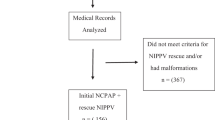Abstract
We describe our experience with use of variable-flow nasal continuous positive airway pressure (NCPAP) to manage postextubation stridor in a 31-month-old child with Down syndrome (DS). Although it has been recognized that children with DS tend to develop obstruction of the upper airway postoperatively, little is known concerning appropriate management of this situation. Although there are surprisingly few reports of use of variable-flow NCPAP for children older than preterm infants, we successfully treated postextubation ventilatory complications by providing variable-flow NCPAP without complications such as pneumothorax.
Similar content being viewed by others
References
AL de Jong M Sulek M Nihill NO Duncan EM Friedman (1997) ArticleTitleTenuous airway in children with trisomy 21 Laryngoscope 107 345–350 Occurrence Handle1:STN:280:ByiB3sflt1E%3D Occurrence Handle9121311
SR Shott (2000) ArticleTitleDown syndrome: analysis of airway size and a guide for appropriate intubation Laryngoscope 110 585–592 Occurrence Handle1:STN:280:DC%2BD3c3isFSksA%3D%3D Occurrence Handle10764002
R Downey SuffixIII RM Perkin J MacQuarrie (2000) ArticleTitleNasal continuous positive airway pressure use in children with obstructive sleep apnea younger than 2 years of age Chest 117 1608–1612 Occurrence Handle10.1378/chest.117.6.1608 Occurrence Handle10858391
G Moa K Nilsson H Zetterstrom L Jonsson (1988) ArticleTitleA new device for administration of nasal continuous positive airway pressure in the newborn: an experimental study Crit Care Med 16 1238–1242 Occurrence Handle1:STN:280:BiaD2M3jtVI%3D Occurrence Handle3056654
S Gherini RM Peters RW Virgilio (1979) ArticleTitleMechanical work on the lungs and work of breathing with positive end-expiratory pressure and continuous positive airway pressure Chest 76 251–256 Occurrence Handle1:STN:280:CSaB3srmvVA%3D Occurrence Handle380939
PB Pandit SE Courtney KH Pyon JG Saslow RH Habib (2001) ArticleTitleWork of breathing during constant- and variable-flow nasal continuous positive airway pressure in preterm neonates Pediatrics 108 682–685 Occurrence Handle10.1542/peds.108.3.682 Occurrence Handle1:STN:280:DC%2BD3MvptFSluw%3D%3D Occurrence Handle11533336
M Mazzella C Bellini MG Calevo F Campone D Massocco P Mezzano E Zullino F Scopesi Arioni W Bonacci G Serra (2001) ArticleTitleA randomised control study comparing the Infant Flow Driver with nasal continuous positive airway pressure in preterm infants Arch Dis Child Fetal Neonatal Ed 85 F86–F90 Occurrence Handle1:STN:280:DC%2BD3MvntFOrsA%3D%3D Occurrence Handle11517199
Author information
Authors and Affiliations
About this article
Cite this article
Ito, H., Sobue, K., So, MH. et al. Postextubation airway management with nasal continuous positive airway pressure in a child with Down syndrome. J Anesth 20, 106–108 (2006). https://doi.org/10.1007/s00540-005-0372-7
Received:
Accepted:
Issue Date:
DOI: https://doi.org/10.1007/s00540-005-0372-7




